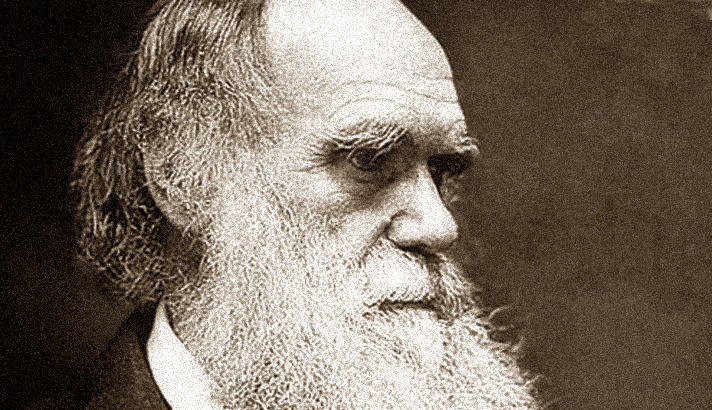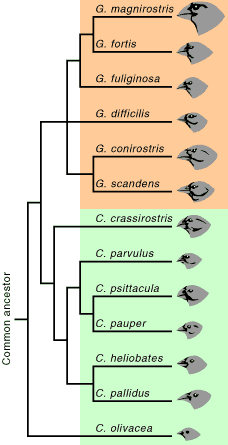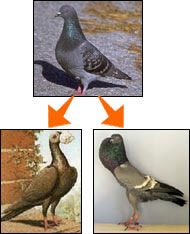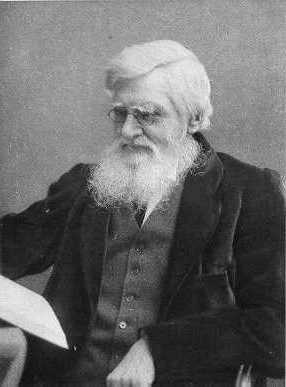What Did Alfred Wallace Discover
 The genius of Darwin (left), the mode in which he of a sudden turned all of biology upside down in 1859 with the publication of theOrigin of Species, can sometimes requite the misleading impression that the theory of evolution sprang from his forehead fully formed without any precedent in scientific history. Merely every bit earlier chapters in this history have shown, the raw textile for Darwin's theory had been known for decades. Geologists and paleontologists had made a compelling case that life had been on Earth for a long time, that information technology had changed over that time, and that many species had become extinct. At the same time, embryologists and other naturalists studying living animals in the early 1800s had discovered, sometimes unwittingly, much of the all-time evidence for Darwin's theory.
The genius of Darwin (left), the mode in which he of a sudden turned all of biology upside down in 1859 with the publication of theOrigin of Species, can sometimes requite the misleading impression that the theory of evolution sprang from his forehead fully formed without any precedent in scientific history. Merely every bit earlier chapters in this history have shown, the raw textile for Darwin's theory had been known for decades. Geologists and paleontologists had made a compelling case that life had been on Earth for a long time, that information technology had changed over that time, and that many species had become extinct. At the same time, embryologists and other naturalists studying living animals in the early 1800s had discovered, sometimes unwittingly, much of the all-time evidence for Darwin's theory.
Pre-Darwinian ideas about development

It was Darwin'south genius both to show how all this evidence favored the evolution of species from a common ancestor and to offering a plausible mechanism by which life might evolve. Lamarck and others had promoted evolutionary theories, but in order to explain only how life changed, they depended on speculation. Typically, they claimed that evolution was guided by some long-term trend. Lamarck, for example, thought that life strove over fourth dimension to rise from simple single-celled forms to complex ones. Many German biologists conceived of life evolving according to predetermined rules, in the aforementioned fashion an embryo develops in the womb. Merely in the mid-1800s, Darwin and the British biologist Alfred Russel Wallace independently conceived of a natural, even observable, way for life to modify: a procedure Darwin called natural choice.
The pressure of population growth
Interestingly, Darwin and Wallace plant their inspiration in economics. An English parson named Thomas Malthus published a book in 1797 calledEssay on the Principle of Population in which he warned his young man Englishmen that most policies designed to assistance the poor were doomed because of the relentless pressure of population growth. A nation could easily double its population in a few decades, leading to dearth and misery for all.
When Darwin and Wallace read Malthus, it occurred to both of them that animals and plants should also be experiencing the same population pressure. It should accept very little time for the world to be knee-deep in beetles or earthworms. Simply the earth is non overrun with them, or whatsoever other species, because they cannot reproduce to their full potential. Many die earlier they become adults. They are vulnerable to droughts and cold winters and other environmental assaults. And their food supply, like that of a nation, is not space. Individuals must compete, albeit unconsciously, for what little food in that location is.
Selection of traits

In this struggle for existence, survival and reproduction do not come up down to pure chance. Darwin and Wallace both realized that if an animal has some trait that helps information technology to withstand the elements or to breed more than successfully, it may get out more offspring behind than others. On boilerplate, the trait will become more common in the following generation, and the generation subsequently that.
As Darwin wrestled with natural selection he spent a great deal of time with dove breeders, learning their methods. He found their work to be an illustration for evolution. A pigeon breeder selected individual birds to reproduce in order to produce a neck ruffle. Similarly, nature unconsciously "selects" individuals improve suited to surviving their local conditions. Given plenty time, Darwin and Wallace argued, natural selection might produce new types of body parts, from wings to eyes.
Darwin and Wallace develop similar theory

Darwin began formulating his theory of natural selection in the belatedly 1830s but he went on working quietly on it for 20 years. He wanted to aggregate a wealth of evidence before publicly presenting his thought. During those years he corresponded briefly with Wallace (right), who was exploring the wildlife of South America and Asia. Wallace supplied Darwin with birds for his studies and decided to seek Darwin'southward assistance in publishing his own ideas on evolution. He sent Darwin his theory in 1858, which, to Darwin's shock, virtually replicated Darwin'south own.

Charles Lyell and Joseph Dalton Hooker arranged for both Darwin'south and Wallace's theories to be presented to a meeting of the Linnaean Society in 1858. Darwin had been working on a major volume on evolution and used that to developOn the Origins of Species, which was published in 1859. Wallace, on the other hand, continued his travels and focused his study on the importance of biogeography.
The book was not only a best seller simply also one of the virtually influential scientific books of all time. Withal information technology took time for its full statement to take hold. Within a few decades, most scientists accepted that development and the descent of species from common ancestors were existent. But natural option had a harder time finding acceptance. In the tardily 1800s many scientists who called themselves Darwinists actually preferred a Lamarckian explanation for the fashion life changed over time. It would take the discovery of genes and mutations in the twentieth century to make natural selection not simply attractive equally an caption, merely unavoidable.
What Did Alfred Wallace Discover,
Source: https://evolution.berkeley.edu/the-history-of-evolutionary-thought/1800s/natural-selection-charles-darwin-alfred-russel-wallace/
Posted by: mossgess1946.blogspot.com


0 Response to "What Did Alfred Wallace Discover"
Post a Comment